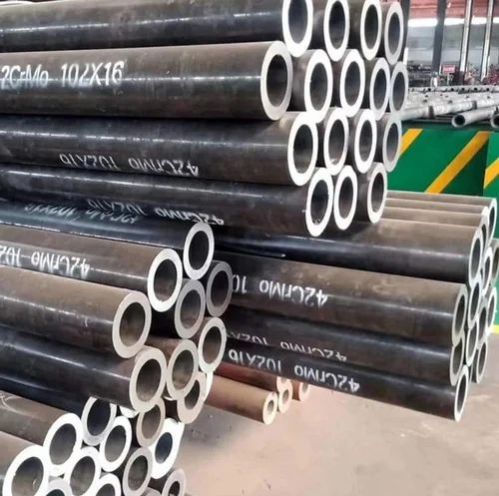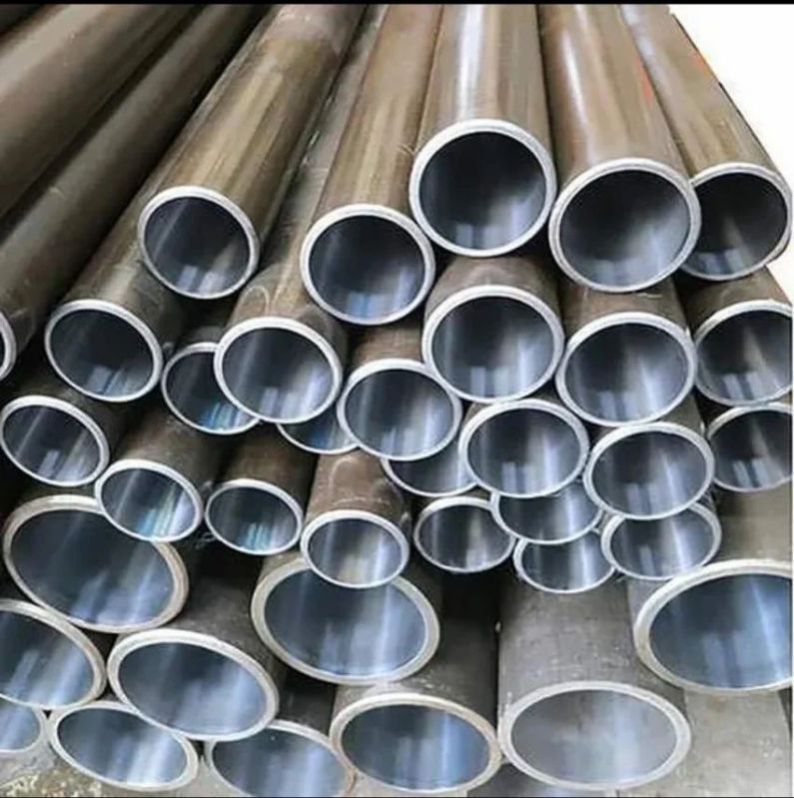- GST NO. : 24AIYPR7180G1ZK
bhagwatienterprise25@yahoo.com
Pipe Tubes
Leading Manufacturers, Exporters, Wholesaler, Retailer and Trader of Carbon Steel Seamless Pipe Tube and Mild Steel Hydraulic Honed Tube from Vadodara.
| Business Type | Manufacturer, Exporter, Supplier, Retailer, Trader, Distributor, Importer |
| Thickness | 10-20mm |
| Length | 4000-5000mm |
| Certification | ISI Certified |
| Material Grade | Carbon Steel |
| Brand Name | Bhagwati |
| Material | Carbon Steel |
| Finishing | Non Poilshed |
| Shape | Round |
| Application | Marine Applications, Construction, Industrial Use |
| Feature | Perfect Shape, High Strength, Fine Finishing, Excellent Quality |
| Country of Origin | India |
| Color | Black |
| Size/Diameter | 3 Inches |
| Packaging Type | Black |
| Number Of Flower | Carbon Steel Seamless Pipes |
| Port | Vadodara |
| Payment Terms | L/C, D/A, D/P, T/T |
| Delivery Time | Same Day |
| Packaging Details | Loose |
Carbon steel tubes are hollow cylindrical products made from a steel alloy of iron and carbon, offering high strength, durability, and versatility. They are widely used in various industries like oil and gas, construction, and manufacturing due to their cost-effectiveness and ability to withstand high pressures and temperatures. Carbon steel tubes can be either seamless (made without welding) or welded, with seamless tubes being ideal for applications requiring uniform strength and structural integrity.
Here's a more detailed look at carbon steel tubes:
Composition and Properties:
- Carbon steel is primarily composed of iron and carbon, with varying carbon content influencing its properties.
- It offers high tensile strength, durability, and good weldability, making it a popular choice for various applications.
- Carbon steel tubes can be manufactured with different grades and specifications, such as ASTM A106B for high-temperature and pressure applications.
Types and Manufacturing:
- Seamless tubes: Produced without welding, ensuring uniform strength and structural integrity.
- Welded tubes: Manufactured by joining steel plates or strips using various welding techniques.
- Manufacturing methods: Include hot rolling, cold drawing, and various welding techniques.
- Cold-drawn tubes: Known for their smooth surface finish and precise dimensional accuracy.
Applications:
- Construction: Used in buildings, bridges, and other structural applications.
- Oil and gas: Used in pipelines, well casings, and other oil and gas equipment.
- Manufacturing: Used in machinery, equipment, and other industrial applications.
- Transportation: Used in maritime, automotive, and other transportation industries.
- Boilers and heat exchangers: Used in heat transfer systems and power plants.
Advantages:
- Cost-effective: Relatively inexpensive compared to other materials.
- High strength and durability: Suitable for demanding applications.
- Versatile: Can be fabricated into various shapes and sizes.
- Weldable: Can be joined with other materials using various welding techniques.
Carbon Steel Seamless Pipes Dealer in Vadodara, CS Seamless Pipe Stockholder in Rajkot, Black Steel Seamless Pipes, Carbon Steel ASTM A106 Seamless Pipes in Vadodara, Carbon Steel Seamless Pipes Distributor in Ankleshwar.
Carbon Steel Seamless Pipe
- Seamless Carbon Steel Pipe
- ASTM A106 Seamless Pipe
- ASTM A53 Carbon Steel Pipe
- API 5L Seamless Pipe
- SCH 40 Seamless Pipe
- SCH 80 Carbon Steel Pipe
- Industrial Seamless Pipe
- Hot Rolled Seamless Pipe
- Export Quality Seamless Pipe
- Seamless Pipe Manufacturer in India Vadodara
- OEM Seamless Pipe Supplier
- B2B Supplier of Carbon Steel Pipes
- Bulk Seamless Pipe Exporter
- Wholesale Seamless Pipe Distributor in Vadodara
- MS Seamless Pipe Manufacturers in Vadodara:
- MS Seamless Pipe Suppliers in India:
- Jindal Seamless Pipes:
- Top MS Seamless Pipe Manufacturers:
- Carbon Steel Seamless Pipes Manufacturer, Supplier, and Dealer in India
- IS 1239 Mild Steel Pipe Exporter
- Mild Steel Pipe Importers
- Industrial MS Pipe Stockists
- Low Carbon Steel Pipe Distributor
- MS Tube Wholesale Dealers
| Business Type | Manufacturer, Exporter, Supplier, Retailer, Trader, Distributor |
| Country of Origin | India |
| Finishing | Polished |
| Feature | Excellent Quality, Fine Finishing, Premium Quality |
| Application | Automobile Industry |
| Length | 1000-2000mm, 6 Meter |
| Shape | Round |
| Material | Mild Steel |
| Hollow Sections | Circular |
| Size | >4 inch |
| Steel Grade | 4140 |
| Packaging Type | Silver |
| Port | Vadodara |
| Payment Terms | L/C, D/A, D/P, T/T |
| Delivery Time | Same Day |
| Packaging Details | Loose & Bundle |
Honed tubes, also known as hydraulic cylinder tubes or honed pipes, are precision-engineered tubes with a smooth, polished inner surface achieved through a specialized process called honing. This process uses abrasives to grind and polish the inner diameter, creating a surface ideal for hydraulic and pneumatic applications requiring efficient fluid flow and reliable sealing.
Here's a more detailed breakdown:
-
Honing Process:Honing is a controlled abrasive machining technique where an abrasive stone is rotated and pushed against the inner surface of the tube. This process removes material and creates a highly polished, smooth finish.
-
Benefits of Honing:
- Improved Fluid Flow: The smooth surface reduces friction, allowing for efficient fluid flow within hydraulic and pneumatic systems.
- Enhanced Sealing: The precision and smoothness of the honed surface ensure a tight seal between the tube and other components, preventing leaks and ensuring system reliability.
- Corrosion Resistance: The polished surface is less prone to corrosion and can improve the overall durability of the system.
- Improved Fluid Flow: The smooth surface reduces friction, allowing for efficient fluid flow within hydraulic and pneumatic systems.
-
Applications:Honed tubes are commonly used in hydraulic and pneumatic cylinders, as well as in other applications where smooth, precise internal surfaces are critical for fluid flow and sealing.
Materials:
Honed tubes can be made from various materials, including stainless steel, carbon steel, non-ferrous metals, and alloy steel.
- Mild Steel Honed Tubes, Carbon Steel Honed Tube in Vapi, CS/MS Honed Tubes Dealer in Surat, CS/MS Honed Tubes in Vadodara, CS/MS Honed Tubes Stockholder in Rajkot, CS/MS Honed Tubes Distributor in Ankleshwar.
- Honed Pipe Supplier in Vadodara
- Honed Tube
- Precision Honed Tube
- Hydraulic Honed Tube
- Hydraulic Honed Pipe
- Seamless Honed Tube
- Cold Drawn Honed Tube
- Steel Honed Pipe
- Honed Cylinder Tube
- Hydraulic Cylinder Honed Pipe
- Seamless Honed Pipe
- Cold Drawn Seamless Tube
- ST52 Hydraulic Honed Tube Manufacturer”
- “Precision Honed Cylinder Tubes for Hydraulic Cylinders”
- “Cold Drawn Seamless Honed Tubes for OEM Applications”
- “Heavy-Duty Honed Tubes for Construction Equipment”
- “High-Precision Skived and Roller Burnished Tubes Exporter”
- Manufacturer of…
- Exporter of…
- Supplier of…
- Stockist of…
- Custom Honed Tubes


